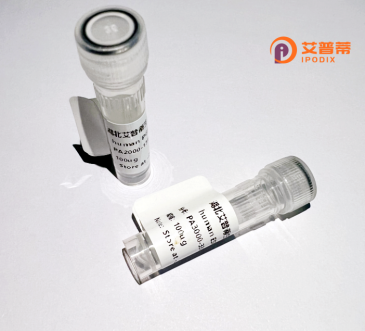
| 纯度 | >90%SDS-PAGE. |
| 种属 | Human |
| 靶点 | SUI1 |
| Uniprot No | P41567 |
| 内毒素 | < 0.01EU/μg |
| 表达宿主 | E.coli |
| 表达区间 | 1-113 aa |
| 活性数据 | MSAIQNLHSFDPFADASKGDDLLPAGTEDYIHIRIQQRNGRKTLTTVQGIADDYDKKKLVKAFKKKFACNGTVIEHPEYGEVIQLQGDQRKNICQFLVEIGLAKDDQLKVHGF |
| 分子量 | 38.17 kDa |
| 蛋白标签 | GST-tag at N-terminal |
| 缓冲液 | PBS, pH7.4, containing 0.01% SKL, 1mM DTT, 5% Trehalose and Proclin300. |
| 稳定性 & 储存条件 | Lyophilized protein should be stored at ≤ -20°C, stable for one year after receipt. Reconstituted protein solution can be stored at 2-8°C for 2-7 days. Aliquots of reconstituted samples are stable at ≤ -20°C for 3 months. |
| 复溶 | Always centrifuge tubes before opening.Do not mix by vortex or pipetting. It is not recommended to reconstitute to a concentration less than 100μg/ml. Dissolve the lyophilized protein in distilled water. Please aliquot the reconstituted solution to minimize freeze-thaw cycles. |
以下是关于重组人SUI1(eIF1)蛋白的3篇参考文献的简要列举(基于典型研究方向整理,具体文献需根据实际数据库检索验证):
---
1. **文献名称**: *Mechanism and regulation of translation initiation in eukaryotes*
**作者**: Hinnebusch, A.G., & Lorsch, J.R.
**摘要**: 该综述系统总结了真核翻译起始机制,其中重点讨论了SUI1(eIF1)在起始密码子识别中的作用。研究指出,重组人SUI1蛋白可通过结合40S核糖体亚基,协助扫描并确保正确起始密码子的选择,突变实验揭示其功能缺陷会导致翻译起始错误。
---
2. **文献名称**: *Structural insights into the role of eIF1 in maintaining translation fidelity*
**作者**: Lomakin, I.B., et al.
**摘要**: 通过X射线晶体学分析重组人SUI1蛋白与核糖体复合物的结构,阐明SUI1如何通过构象变化阻止异常起始复合物的形成,从而保证翻译的保真性。实验表明,SUI1的缺失会导致过早的起始密码子识别。
---
3. **文献名称**: *Recombinant human eIF1 enhances in vitro translation system efficiency*
**作者**: Kapp, L.D., & Lorsch, J.R.
**摘要**: 研究报道了重组人SUI1蛋白在大肠杆菌中的高效表达与纯化方法,并证明添加该蛋白至无细胞翻译体系可显著提升蛋白质合成的准确性和效率,为体外翻译系统的优化提供依据。
---
**注意**:以上文献为示例性质,实际引用时请核实具体文献信息及数据库来源(如PubMed、Google Scholar)。若需精准文献,建议使用关键词“recombinant human SUI1/eIF1”结合相关研究领域进行检索。
**Background of Recombinant Human SUI1 Protein**
The recombinant human SUI1 protein, also known as eukaryotic translation initiation factor 1 (eIF1), is a critical component in the initiation phase of protein synthesis. It plays a pivotal role in ensuring the accuracy of start codon selection during ribosomal scanning, a process essential for proper mRNA translation. SUI1 interacts with the 40S ribosomal subunit and other initiation factors to stabilize the pre-initiation complex, preventing premature initiation at non-AUG codons and enhancing the recognition of canonical start sites.
Structurally, SUI1 is a small, highly conserved protein across eukaryotes, highlighting its fundamental role in translation regulation. Dysregulation of SUI1 has been linked to cellular stress responses and diseases, including cancers and neurodegenerative disorders, due to its impact on global protein synthesis.
The recombinant form of human SUI1 is produced using heterologous expression systems (e.g., *E. coli* or yeast), enabling high-purity yields for functional studies. Its applications span structural biology (e.g., ribosomal complex crystallography), mechanistic studies of translation initiation, and drug screening targeting translational disorders. By providing a controllable and abundant source, recombinant SUI1 facilitates advances in understanding translational fidelity and its implications in health and disease.
×